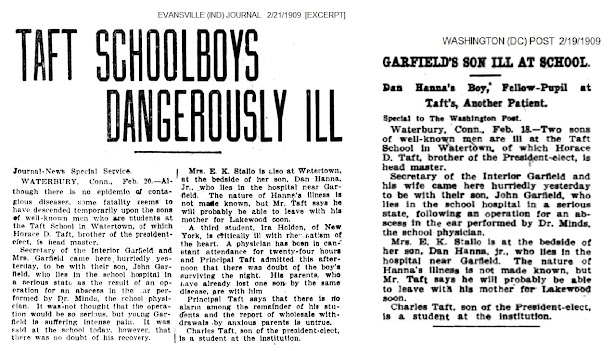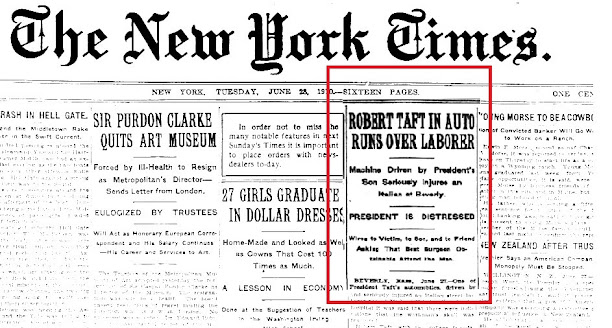On Tuesday, June 21, 1910, front page newspaper headlines from coast to coast loudly proclaimed that John Garfield, the grandson of President Garfield, had been expelled from the Taft School in Watertown, Connecticut.
(Click any image to enlarge and twice to magnify).
John's grandfather President Garfield took office in March, 1881 and was assassinated seven months later. Here he is being embalmed with the presidential-sized needle.
President's Garfield's son James witnessed the shooting at age 15 and later became Secretary of the Interior under President Teddy Roosevelt.
Secretary of the Interior James Garfield decided to send his son John to the Taft School in Watertown Connecticut.
Taft School Founder and Headmaster (not "Head of School") was Horace Dutton Taft, who like the Garfield clan hailed from Ohio.
According to the newspapers, which are the primary source for this article, the Garfields and the Tafts saw each other socially and even as house guests.
Besides President Garfield's grandson (upper circle), the student body of eighty contained another boy with presidential connections, Charlie Taft. Charlie (lower circle) was the son of William Taft who was Teddy Roosevelt's Secretary of War. Charlie's uncle was Headmaster Taft.
Charlie entered Taft when he was only eleven years old just at the time his dad was running for president.
This very simple chart illustrates the class nomenclature with lower school boys on the left and upper school boys on the right. Charlie Taft entered as an eighth grade Junior, but he was actually a sub-sub-Junior, a sixth grader. That same year, Garfield's grandson was a mid.
A third major character in this preparatory fairy story is the Soldier's Monument (green arrow) which was erected a month after the arrival of Charlie. Located across from Watertown Town Hall and quite near to the school, the towering spar was "36 feet high surmounted with a bronze eagle weighing 670 pounds."
Less than a week after the unveiling, Garfield's unsmiling grandson was suspended for hazing "four younger boys."
The New York Times stated on page eleven that besides Garfield, three other boys were being suspended, including Kenneth Monteagle of San Francisco, Fred Andrews of New York, and Henry Fownes of Pittsburgh.
As the son of a Pittsburgh millionaire, Henry Fownes made front page news in his home town paper which labeled all four boys as "sons of prominent men."
The Cleveland Plain Dealer, loyal to local boy Garfield, painted him as the victim, forgetting the hazees.
The New York Sun claimed the unnamed lower classmen were taken from their beds naked and subjected to "pairing off."
According to an obscure website, "pairing off" was an enforced slapping contest between two friends. The boys were "ordered to slap each other" prompting "a brutal scene of friends turning on each other." Below, an assemblage of lower classmen, just waiting to be dragged from their beds naked and slapped.
The unusual class cross-section of perpetrators included Fownes, a senior and presumably the ringleader; two mids, Garfield and Andrews; and upper mid Monteagle, below.
The next month brought the more wholesome news that Charlie Taft's father had been elected president.
A portrait of Charlie's family included his parents (top row), his stolid older brother Robert (who had graduated Taft two years before), sister Helen, and the beaming boy himself, front and center. Charlie became a national figure and got to ride sidesaddle next to the Presidential chauffeur.
Unfortunately the news for Garfield's grandson's father was not so good.
Garfield's grandson reclaimed the national spotlight by becoming ill, prompting his parents to come hurriedly to Watertown. Receiving second billing (right) was ailing millionaire heir Dan Hanna whose mom, Mrs. E. K. Stallo, knew her way from Cleveland to Watertown because barely two years before, her 20-year-old upper middler son Mark Hanna had run off to Waterbury to get himself an actress.Garfield's grandson rebounded from his illness sufficiently to be taken home to Washington DC by Headmaster Taft, his wife, and a number of other Taft school students.
As discussed in "How Theatre People Saved the Masque and Dagger" Charlie Taft appeared in drag in Taft's spring stage play "Private Secretary."
Taking advantage of the long Easter break resulting from an epidemic of diptheria, Charlie went home to the White House to have his tonsils removed. While witnessing his operation, Charlie's mother suffered a "nerve breakdown" (stroke) from which she never fully recovered.
The school year 1909-1910 began on a glum note owing to the illness and death of Winnie Taft, the Headmaster's wife. "Miss Winnie" was immensely popular, especially among the lower school boys.
Amidst restrained hoopla, Charlie Taft's father arrived in Watertown for the funeral and poor little Charlie was batted off the train platform three times before he was rescued by Captain A.W. Butt, the President's Chief Adjutant and golfing partner.
"My wife fell ill in the fall and died in December," wrote Horace Taft in his memoirs, thirty-five years later. "It is the kind of blow that divides a man's life in two. There was nothing to do but throw myself into the work of the school as completely as possible."
School life began to perk up in the spring when the Headmaster granted seniors the right to smoke and a house in which to do it "provided they discouraged the practice in other class men."
Charlie Taft (green arrow) took to the stage for yet another drag role in Pinero's "The Amazons" a comedy about gender confusion and "the girls from St. Margaret's and fashionable Westover literally bombarded him with violets and roses."
Ten day later came the shocking national news that little Charlie had been ducked by two upper classmen.
With his favorite aunt gone to Heaven and his mother a mute and hopeless invalid, 12-year-old Charlie Taft must have seemed the perfect victim for a dose of cruel hazing,"ducked" by at least two 17-year-old upper mids, Harry J. Crocker and Frederick Andrews. The latter escaped retribution on horseback.
Charlie Taft in 1910, vice-president of the Junior Taft Athletic Association.
"There will be no more open air ducking," proclaimed Headmaster Taft the next day. If punishments were meted out, they were held back from the press.
Three weeks later, all hell broke loose when it was announced in the national press that Garfield's grandson had been expelled from Taft. "Garfield got gay" (left) explained the Leavenworth paper and caused him to "decorate a memorial shaft in the school colors."
Assistant vandal Harry Crocker received front page "Local Boy Makes Bad" headlines in his home town, only just recovered from the 1906 conflagration.
Editorials implied that the whole sordid mess was a conspiracy.
But Deus Ex Teletype, the next day it turned out that Garfield's grandson had NOT been expelled! He had nothing whatever to do with the escapade!! No one was expelled!!!
Headmaster Taft could not have been more emphatic in his denials of the spurious Associated Press story which had appeared in hundreds of newspapers, with front page placement.
This box score is based upon data available at newspapers.com and represents only a tiny percentage of the 2600 dailies in print in 1910. Of particular interest is that only one paper reported accurately on Tuesday, June 21, and that was the New London Day (blue arrow).
How the New London Day knew to print a retraction of a fact not yet published is lost to time.
The soldiers' shaft was desecrated as well as decorated, according to the Day, with a chamber pot tied about the eagle's neck. How on earth did the boys get it up there? There was some potentially climbable filigree on the lower portion of the shaft (green arrow), but the difficulty of this clandestine operation was compounded by the close proximity of a residence and subdued illumination of a not yet full moon.
Two town ladders and a plumber were required to remove "the piece of crockery seldom seen outside of a bedroom."
The three culprits let to right, lower mid Austin Dunham, middler Harry Crocker, and upper mid Frederick Andrews had to take their final exams at home and so did Garfield's innocent grandson.
Perhaps Mr. Taft sympathized with the desecration of a Connecticut Civil War monument, saying in his memoirs that the "dreadful handling of the issues at the end of the Civil War has produced a crop of evil, the end of which no man can foresee."
The closing of the hectic 1909-1910 school year was marked with pleasure, halcyon, bucolic, and biblical.
Scarcely ten days after school let out, the President was holding his son Charlie's face and kissing him.
It seems that Charlie's brother Robert (Taft '06) had run over a penniless dago in the family motorcar, the victim seriously injured and tossed into the gutter. Robert's immediate concern was that the accident might cause him to miss the 1910 Yale-Harvard Regatta.
###
Either because they had attended the Taft school or because they were millionaires, almost all the boys mentioned in this story matriculated to Yale. The three exceptions were Kenneth Monteagle (University of California), Harry Crocker (Harvard), and Garfield's grandson, who went on to Williams, like his father and grandfather before him.
But what happened to these boys after college and what is the moral of the story?
Frederick Andrews. Crime: 1908 fall hazing, 1910 Charlie Taft ducking.
Fresh out of Yale, Fred Andrews married far beneath his station to the "Chin-Chin girl" at the New York Hippodrome where it was always Apple Blossom Time.
Eight years later he was dead, a victim of the 1924 typhoid fever epidemic which in New York afflicted only the wealthy.
Harry Crocker. Crime: 1910 Charlie Taft ducking.
Kenneth Monteagle. Crime: 1908 fall hazing.
Proving the point that badly behaved children are a reflection on their parents, both their mothers were killed instantly in the same automobile in 1929 by yet another bad boy.
Henry Fownes. Crime: 1908 fall hazing.
Henry Fownes, whose family introduced golf to Pittsburgh, cheated death by drowning three times, most notably in 1948 (right) when his seventy-three foot yacht exploded.
This millionaire was unable to avoid death by proxy when his five-year-old grandson, left unattended for two hours, perished by falling through a half-frozen pond in January, 1953 and "Fownes Drowns" became a reality. The kindergartner's little brother, Chris, graduated from Taft in 1969.
Garfield's grandson. Crime: 1908 fall hazing.
On May 23rd, 1931, Garfield's grandson shot himself in the head.
The next day, there was no retraction.
Charlie Taft.
Charlie Taft, who went to Heaven in 1983, "was a typical Taft who placed public service above making money," read the Cincinnati Post. "There is no Republican way or no Democratic way to pave a street," said Mayor Charlie.
At Yale Charlie earned "the highest honor that could be accorded," followed in rank ironically by Garfield's grandson's little brother Newell.
Charlie graduated from the Taft School at age fifteen, where he was "popular among his schoolmates, and is liked by the townsfolk, because he has indulged in none of the school pranks."
August, 2024.
For an index of other Taft School articles, click here. For a master index of all of Bob Foreman's photo-essays, click here.







%20STUDENT%20BODY%20JOHN%20GARFIELD%20CHARLIE%20TAFT.jpg)








%20JUNIORS%20REDS.jpg)
%20MONTEAGLE%20crop.jpg)















%20JUNIORS%20BLUES%20CHARLIE%20TAFT%20CROP%20LETTER.jpg)




























